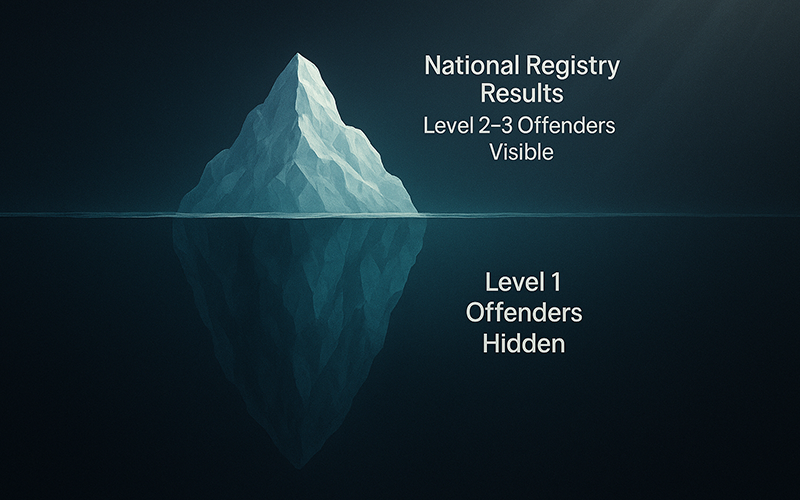Here's a wake-up call that'll make your HR team sweat: that "comprehensive" national sex offender search you're running? It's missing thousands of convicted sex offenders. Not because of a glitch. Not because of outdated data. By design.
We're talking about a gap so significant that employers relying solely on the National Sex Offender Registry are essentially playing Russian roulette with workplace safety. Level 1 sex offenders - still convicted, still dangerous, still legally required to register - simply don't exist in the national database. They're invisible to your "thorough" background check.
However, here's where it gets fascinating: most employers are unaware of this gap. They're checking one box, feeling confident about their due diligence, and unknowingly exposing their organizations to catastrophic liability. Meanwhile, the smart money is running dual searches - national and state-specific registries - because they understand what's actually at stake.
The registry system isn't broken; it's just more complex than anyone wants to admit. In a world where one missed red flag can trigger lawsuits, regulatory violations, and reputation-destroying incidents, "good enough" screening isn't good enough anymore.
Time to stop gambling with gaps most don’t know existed.
The National Registry: Powerful, Popular, and Dangerously Incomplete
The Dru Sjodin National Sex Offender Public Website (NSOPW) looks like the holy grail of sex offender screening. One search. Nationwide coverage. All 50 states, DC, territories, and 150+ tribal nations rolled into a single query. What's not to love?
Here's what the National Sex Offender Registry actually delivers - and what it doesn't:
The Coverage That Impresses:
- Records from over 200 different jurisdictions.
- Consolidated search across state, territorial, and tribal databases.
- Real-time access to registration information nationwide.
- Standardized search interface that cuts through individual state variations.
The Information You Get:
- Offender name, aliases, and identifying characteristics.
- Current and historical addresses.
- Physical descriptions and photographs.
- Conviction details (when provided by reporting jurisdiction).
- Registration status and compliance history.
Sounds comprehensive, right? Here's where marketing meets reality.
The National Sex Offender Registry only includes Level 2 and Level 3 offenders - the highest risk classifications. Level 1 offenders, classified as the lowest risk for repeat offenses, are excluded entirely from the national database.
Let that sink in. We're not talking about a technical oversight or a temporary gap. This is how the system was designed. Level 1 sex offenders are systematically excluded from the "comprehensive" national search that most employers rely on.
Even for the offenders who are included, the national registry is only as current as the information each jurisdiction chooses to submit. Some states update daily. Others update quarterly. Some provide detailed conviction information. Others send bare-bones data.
According to National Employment Law Project reports, the FBI's own database is missing final disposition information for approximately 50% of its arrest records. When you're dealing with a patchwork system of 200+ jurisdictions, each with different reporting standards and update frequencies, "comprehensive" becomes a relative term.
Every time you run a national-only search, you're making a bet. You're betting that your candidate was never a Level 1 offender in any state. You're betting that all relevant conviction details made it from state systems to the national database. You're betting that the timing of updates aligns with your screening timeline.
Those are expensive bets to make with your organization's safety and legal exposure on the line.
The national registry isn't worthless - it's an excellent starting point that casts the widest possible net. But treating it as the final answer? That's where smart screening ends and dangerous assumptions begin.
The State Registry: Where the Missing Pieces Live
While employers are putting all their faith in the national system, the real action is happening at the state level. Every single state maintains its own sex offender registry with different rules and different offenders that never make it to the national database.
This isn't a backup system. It's where the gaps get filled.
What State Registries Contain:
- Complete risk classifications including the Level 1 offenders missing from national searches
- You might have to call in and verify over the phone in some states. Not all publish records online.
- Additional conviction details that states choose not to share nationally
- More frequent updates with state-specific timing requirements.
- Enhanced verification protocols that go beyond basic database matching.
- Local monitoring requirements and compliance details that affect risk assessment.
Level 1 sex offenders represent a significant portion of the total registered population in most states. These aren't minor infractions or technicalities - these are convicted sex offenders who completed their sentences and are required to register. They're just classified as lower risk for repeat offenses.
But "lower risk" doesn't mean "no risk," and it certainly doesn't mean "irrelevant to employment decisions." A Level 1 offender convicted of voyeurism might be perfectly suitable for most positions but completely inappropriate for roles involving access to private spaces or security cameras.
Take California's Sex and Arson Registry (CSAR). It includes detailed offense descriptions, multiple conviction dates, and specific restrictions that never appear in national searches. New York's registry requires direct phone verification for certain classifications - information you'll never get from an automated national search.
Some states provide:
- Detailed offense descriptions and circumstances.
- Multiple conviction histories that show patterns.
- Current supervision status and restrictions.
- Employment limitations ordered by courts.
- Address restrictions that might affect job performance.
Sex offenders move. A lot. They relocate for work, family, or fresh starts, and each state they've lived in maintains its own records with different details and different classifications.
An offender might be Level 2 in Texas but Level 1 in Florida based on different state classification systems. The national registry might show the Texas classification while missing the Florida registration entirely if the timing doesn't align with interstate reporting requirements.
Every state registry search reveals information that doesn't exist anywhere else. These aren't redundant systems - they're complementary databases that together create the complete picture that single-source searches miss.
Skipping state-specific searches isn't just cutting corners. It's ignoring entire categories of relevant information that could be critical to your hiring decisions and legal compliance.
The Two-Registry Strategy: Why Both Searches Are Non-Negotiable
Here's the uncomfortable truth: comprehensive sex offender screening isn't a choice between national OR state registries. It's national AND state registries, every single time. Any other approach is just expensive wishful thinking.
The two-registry strategy isn't about being thorough for the sake of being thorough. It's about plugging systematic holes that single-source searches leave wide open. When Level 1 offenders, state-specific details, and verification requirements all live in different databases, one search simply cannot deliver complete results.
National Registry First (NSOR/NSOPW)
Start with the broadest possible net. The national search identifies potential matches across all jurisdictions where the candidate might have lived, worked, or attended school. This gives you the geographic scope and initial risk assessment framework.
What you're looking for:
- Any registry presence nationwide.
- Multiple state registrations that indicate mobility.
- Level 2/Level 3 classifications that demand immediate attention.
- Address history that reveals additional states to search.
State-Specific Verification and Expansion
For every state identified with the National search, plus every state where the candidate has lived for the past 7-10 years, run individual state registry searches. This is where you find the missing Level 1 offenders and verify the details from national results.
Critical state-level intelligence:
- Complete risk classifications, including Level 1 offenders.
- Enhanced conviction details and circumstances.
- Current compliance status and restrictions.
- Direct verification when required by state protocols.
- Local monitoring requirements that affect employment suitability.
In high-stakes hiring environments - healthcare, education, childcare, financial services - single-registry searches are becoming legally indefensible. Regulatory bodies, insurance providers, and legal standards are evolving to expect comprehensive screening that accounts for known system limitations.
The two-registry strategy isn't the gold standard anymore. It's the minimum standard for organizations that take screening seriously.
You can run one search and hope you got everything. Or you can run comprehensive searches and know you got everything searchable. In a litigation-conscious world where "we didn't know" isn't a viable defense, that difference is worth everything.
No Shortcuts on Safety
The registry landscape has evolved beyond simple database searches into a complex web of federal systems, state requirements, and legal restrictions that most employers navigate blindly. The stakes? Miss a Level 1 offender because you only searched national databases, and you're explaining to a jury why your "comprehensive" background check wasn't actually comprehensive.
The registry system is complex, legally fraught, and constantly changing. Organizations that try to navigate it with DIY approaches or cut-rate providers are gambling with their most valuable assets: their people, their reputation, and their legal standing.
Call CIChecked today at (518) 271-7546 because knowing what you're missing is the first step to fixing it.

%20Featured%20Image.png?width=160&height=105&name=What%20Journalists%20Taught%20Us%20About%20Social%20Media%20Screening%20(And%20Why%20HR%20Should%20Listen)%20Featured%20Image.png)


%20Featured%20Image.png)

